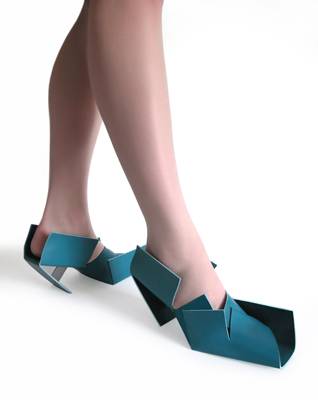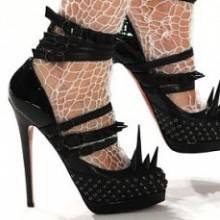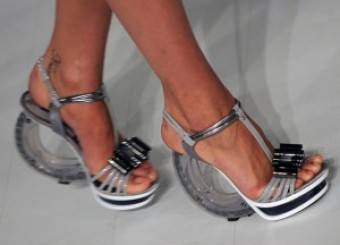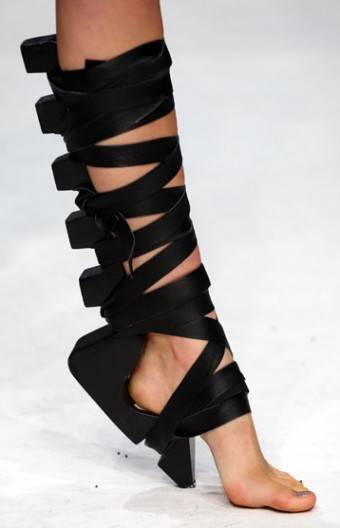 The current exhibit of innovative shoe designer Marloes ten Bhömer at Krannert Art Museum is intriguing, in more ways than one. Footwear made out of folded leather is unusual, and opens visitor’s eyes to the existence of avant-garde footwear beyond the typical gym shoes and ballet flats of everyday. But, there seems to be an underlying tone of exclusivity surrounding it, one that plainly surfaces with the following quote from the exhibit’s fact sheet:
The current exhibit of innovative shoe designer Marloes ten Bhömer at Krannert Art Museum is intriguing, in more ways than one. Footwear made out of folded leather is unusual, and opens visitor’s eyes to the existence of avant-garde footwear beyond the typical gym shoes and ballet flats of everyday. But, there seems to be an underlying tone of exclusivity surrounding it, one that plainly surfaces with the following quote from the exhibit’s fact sheet:
“Much attention is paid to shoe designers Manolo Blahnik and Christian Leboutin (sic) for their cult celebrity following and unbelievable price-points. While they design beautiful shoes, they do not stop those of us with design-overdose-syndrome in our tracks.”
Woah. Krannert Art Museum’s standpoint not only produces a loaded quote, but an ironic furthering of the barrier built between the genres of fashion and art. Its pessimistic viewpoint on the modern-era marketplace, overtly displayed through a falsified designer comparison and also the literal writing on the wall of the exhibit, draws negativity toward the masking of innovative designers by more mass-marketed goods from places such as Ikea and Target, and is utterly blasphemous.
Allow me to explain: it’s not that I’m hopping aboard a fashion high horse; it’s simply that, in terms of its designer scapegoating, Krannert Art Museum is just plain wrong. Manolo Blahnik, popularized through Carrie Bradshaw’s unbelievable closet purchased with what seems to be the highest-paid columnist salary of all time, produces shoes that are often overlooked as overpriced luxury goods instead of the purposeful pieces they aim to be. David Ian Weightman, a UIUC professor of industrial design, provides the designer’s side of the argument inside the exhibit’s backhandedly condescending brochure, which, oddly enough, directly contradicts the viewpoint of the museum:
“For some footwear … proper functionality, or better yet, improved functionality is the prime objecive for the designer. How does this affect Jimmy Choo when he sits down to design a pair of high-heeled pumps? The function of this kind of shoe is to make the wearer look and feel spectacular — to make legs look longer, to put the pelvis in an orientation that changes the gait, and to impress with the quality of the materials and construction.”
Christian Louboutin‘s footwear, just like Blahnik and Choo’s, is also touted by celebrities and women across the world mostly for that very reason — the significant architectural difference between those red-bottomed heels and a pair of Mossimo pumps for $29.99 at Target, and not because of their outrageous price tag. But, beneath the argument advocating for designer footwear is an even more important one: Krannert Art Museum has absolutely no idea what it is talking about.
If we’re going to talk Loubies, let’s talk Loubies. The museum’s standpoint seems to balance on the concept of design, but clearly, structural design isn’t a factor. What they’re inferring is that a shoe’s physical appearance is what makes it different or innovative, not the way it makes one walk or feel. And, with that, I present this:


On the left, Christian Louboutin zippered pumps, and on the right, Christian Louboutin for Rodarte. Foldable leather flaps they’re not, but still — sky-high stilettos that evoke imagery of both punk music and inverted stalactites has to be worth some sort of acknowledgement rather than a put down.
Krannert Art Museum also focuses on how the “crowded marketplace” hides innovative designs, thus looking past how avant-garde popular fashion designers have been. Yet, these Marc Jacobs inverted heels (top), Gianfranco Ferre futuristic pumps (middle) and Aminaka Wilmont lace-ups (bottom) are just three jaw-dropping shoes that seem to be just as functional and brow-furrowing as ten Bhömer’s.



But, I digress. The Louboutin zippered pump, copied both high — L.A.M.B, Gwen Stefani’s line, created a suspiciously similar shoe costing a few hundred dollars — and low, represents how clearly the basis of Krannert’s exhibition ignores the current state of the industry and fashion in general. Bondage-inspired goods have become blasé through a hyper-exposure of designer fashions, mostly due to a plethora of weblogs and increased focus on street style, which has allowed for a trickle-down effect of designs so obscure, such as Louboutin for Rodarte’s. The museum boldly ignores that commonplace trends come from somewhere; that the clothing and footwear that most people adorn their bodies with is a watered-down version of what’s been stomped down the catwalk.
These trends, these mass-market products, the same ones Krannert puts down in the exhibit’s opening sentences, are merely accessible versions of the avant-garde and couture styles too costly to obtain. The gladiator sandals of summer, unignorable from beach-y shores to mall storefronts? A trickle-down of Balenciaga’s 2008 spring ready-to-wear and resort collections, which debuted in 2007. The multi-strapped, studded stilettos currently popping up at places like Forever 21? Balmain’s spring 2009 showing. And the diamond-esque leather sandals, copied by many, deemed ugly by most, are none other than direct knockoffs of the Extreme Dior Gladiator Sandal.
Marlos ten Bhömer’s designs are fantastic, there’s no doubt. But, Krannert’s misguided attitude praises one artist, while slamming a bevy of others, a sense of pessimism that, clearly, is misguided and needless.
——
Marloes ten Bhömer’s “Walking Machines” exhibit, part of the DesignMatters series, opened last week at the Krannert Art Museum and is showing until the end of May.








